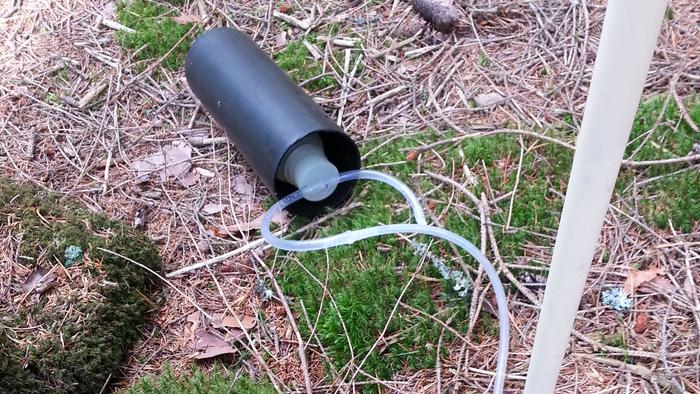- Startpage
- Krondroppsnätet
- SWETHRO
- About SWETHRO
- Soil water chemistry

Soil water chemistry
Deposition measurements are used to quantify the air pollution load on forest ecosystems, while the environmental condition of forest ecosystems is quantified through measurements of soil water chemistry. The chemistry of the soil water is the first to be affected by the deposition of air pollutants as the water makes its way towards groundwater and surface water.
Soil water measurements within SWETHRO, Swedish Throughfall Monitoring Nework, are made in managed forests at a large number of measurement sites all over Sweden. Soil water measurements are carried out three times a year to represent conditions at the beginning, middle, and end of the growing season. Soil water measurements are performed using tension lysimeters that draw water through a fine, ceramic filter. The ceramic body is placed in the mineral soil at a depth of 50 cm, below the actual root zone. Each forest plot contains of five lysimeters. The water is then combined into a composite sample from the plot.
Difference between different tree species
Tree species affect deposition and soil water chemistry differently. Spruce forests are significantly denser than pine and deciduous forests, resulting in higher dry deposition to spruce forests. Consequently, spruce forests have received considerably more deposition over the past decades. Even though dry deposition is now relatively low, the effects of historically high deposition can still be seen in the soil water. Other differences between tree species that can potentially affect recovery from acidification and the ability to retain nitrogen in the soil include nutrient uptake, litter quality, root depth, and ground vegetation.
The measurement sites in SWETHRO aim to represent the most common tree species in different parts of Sweden as comprehensively as possible to account for these differences. For example, in southern Sweden, it is important to have measurements not only in spruce and pine forests but also in deciduous forests.
All work within SWETHRO, from sampling to chemical analysis, validation, and data processing, is conducted according to well-established procedures, and the laboratories are accredited for the chemical analyses. This ensures high-quality data and guarantees that data from different locations and different years are directly comparable.